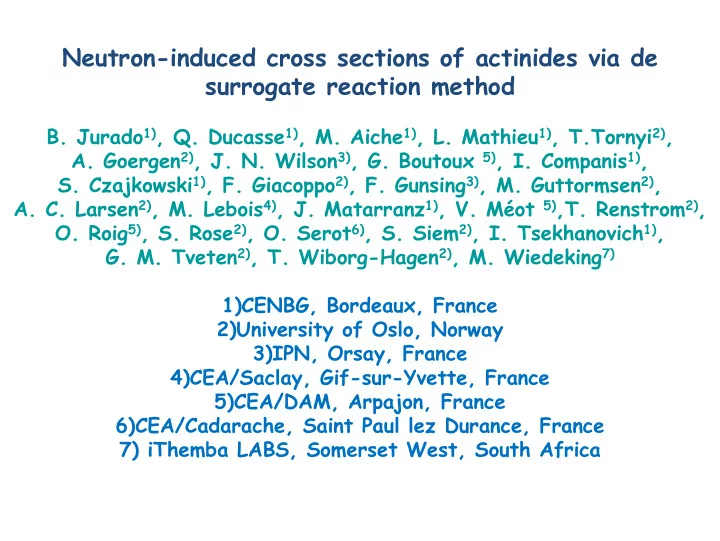

Neutron-induced cross sections of actinides via de surrogate reaction method B. Jurado 1) , Q. Ducasse 1) , M. Aiche 1) , L. Mathieu 1) , T.Tornyi 2) , A. Goergen 2) , J. N. Wilson 3) , G. Boutoux 5) , I. Companis 1) , S. Czajkowski 1) , F. Giacoppo 2) , F. Gunsing 3) , M. Guttormsen 2) , A. C. Larsen 2) , M. Lebois 4) , J. Matarranz 1) , V. Méot 5) ,T. Renstrom 2) , O. Roig 5) , S. Rose 2) , O. Serot 6) , S. Siem 2) , I. Tsekhanovich 1) , G. M. Tveten 2) , T. Wiborg-Hagen 2) , M. Wiedeking 7) 1)CENBG, Bordeaux, France 2)University of Oslo, Norway 3)IPN, Orsay, France 4)CEA/Saclay, Gif-sur-Yvette, France 5)CEA/DAM, Arpajon, France 6)CEA/Cadarache, Saint Paul lez Durance, France 7) iThemba LABS, Somerset West, South Africa
Neutron-induced cross sections of short-lived nuclei in reactor physics Fission and capture cross of e.g. 241,243Am,243Cm(29.1y), • Incineration of minor actinides 244Cm(18.1y),245Cm (8500y) Fission and capture cross sections of e.g. • 232Th/233U cycle 232U(69y), 231Th (26h), 233Th(22m) The data are missing (in particular for capture) due to the high radio-toxicity of the targets involved!
Indirect (n,f) and (n, γ ) measurements: the surrogate method Surrogate reaction Neutron-induced reaction Cramer and Britt (Los Alamos 1970…!!) X + Y n + A (A+1)* • Compound nucleus! • The same spin/parity or no dependence on J/ π ! + + σ = σ A A 1 A 1 ( , ) ( *) ( *). ( *) E E P E χ χ n Calculated Measured (Optical model calculations CEA/Bruyeres le Chatel)
Surrogate method and fission cross sections 243Am(3He,4He)242Am Fission cross section /b 3 241 Am(n,f) 2 CENBG 1 Dabbs et al. JENDL-3.3 & JEFF-3.1 ENDF/B-VII 0 0 2 4 6 8 10 Neutron Energy /MeV G. Kessedjian, et al., Phys. Lett B 692 (2010) 297 How about radiative capture??
Surrogate method applied to capture in rare-earth region Results for 174Yb(3He,p)176Lu 175Lu(n, γ ) Spin distributions G. Boutoux, et al., Phys. Lett B 712 (2012) 319 Very important discrepancies!
Why do we obtain such big differences? E* J=7 15/2+ ‐ 595 keV n ’ 11/2+ ‐ 251 keV 9/2+ ‐ 113 keV S n =6.27MeV 7/2+ 175 Lu γ 7 ‐ 0 176 Lu* Due to the high spin of the decaying nucleus, neutron emission to the ground- and first excited states is highly improbable and gamma emission is highly enhanced! Things should get better when the level density of the nucleus after neutron emission increases --> better for actinides
Surrogate method applied to capture in actinide region Experiment at the Oslo cyclotron: Reactions studied 238 238 3He (24 MeV) d (15 MeV) U U (3He,p) (3He,4He) (d,p) (d,t) 240 237 239 237 (d,d) (3He,t) Np U (3he,d) U U 238 238 238U+n 239 236U+n Np 236U+n U Np 237Np+n Good quality neutron-induced data exist! Good quality neutron-induced data exist (d,p) interesting for inverse kinematics
Experimental set-up at the Oslo cyclotron 28 Scintillators γ -ray detection γ 238 U Fiss. fragments Ejectiles 4 PPACs Fission-fragment detection High efficiency Simultaneous measurement of gamma and fission decay
Determination of decay probability 3He (24 MeV) + 238U 238U(3He,4He γ )237U Δ E/ Ch Counts 4He 3He t d p ( ) E/ Ch E*/ MeV * N E ( ) = co in * P E ( ) ( ) f ⋅ * * N E E ff E Light-particle kinematics + Q-values C N E* of the CN A = + * E E B + n n A 1
First preliminary results: Fission ENDF-VII.1 Fission Probability of 239U* 238U(n,f) CENBG 238U(d,p) at 15 MeV Britt, Cramer 238U(d,p) at 18 MeV 238U(d,p) at 18 MeV H. C. Britt , J. D. Cramer, PRC 2 (1970) 1758 E*/ MeV Deuteron breakup! The neutron is emitted before CN formation (I. Thompson, 2012) E*/ MeV
First very preliminary results: Fission (Analysis with very low statistics, only 1 telescope strip!) Fission Probability 237U* ENDF-VII.1 (neutron induced) 236U(n,f) CENBG (surrogate) 238U(3He,4Hef) E*/ MeV
First very preliminary results: Fission (Analysis with very low statistics, only 1 telescope strip!) Fission Probability 238Np* ENDF-VII.1 (neutron induced) 237Np(n,f) CENBG (surrogate) 238U(3He,tf) E*/ MeV
First very preliminary results: gamma decay 238U(d,p γ )239U* N coin /N CN Fission sets in Sn E*/ MeV This ratio needs to be corrected for the gamma-cascade detection efficiency to get Pgamma !
Conclusions… • Surrogate-reaction method : -->works well for fission -->important discrepancies for capture in rare-earth region due to spin selectivity of neutron emission • New experiment to study capture in actinide region at the Oslo cyclotron � d+238U & 3He+238U � 238U(d,p): fission cross section 25% lower than 238U(n,f), d breakup! � Preliminary fission probabilities from 238U(3He,4He) & 238U(3He,t) agree well with n-induced data � Analysis on the way to extract gamma-decay probabilities …Perspectives • Further study of d-breakup involving theoreticians • Gamma-decay probabilities to be extracted for: 238U(d,p)239U <-> 238U(n, γ ) 238U(d,t)237U <-> 236U(n, γ ) 238U(3He, 4He) 237U <-> 236U(n, γ ) 238U(3He, t) 238Np <-> 237Np(n, γ ) • Evaluate to which extent the surrogate method can be used to extract unknown capture cross sections of short-lived actinides
Recommend
More recommend